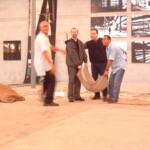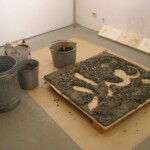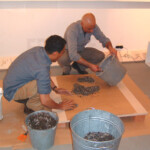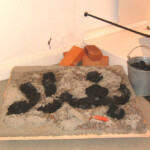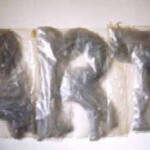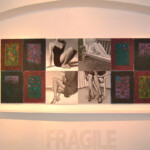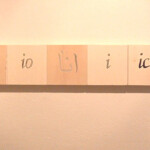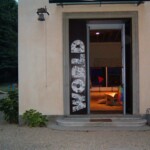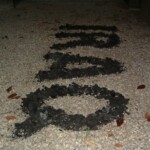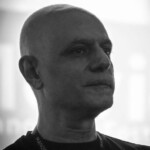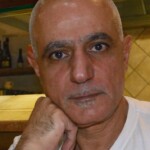Kadhum (Kadhum Ali)
Nasce a Baghdad nel 1961.
Sin dalla tenera età è appassionato di immagini. Il padre e gli zii materni lavoravano nel campo della fotografia. Durante le vacanze estive frequentava la camera oscura e sperimenta la tecnica della stampa in bianco e nero. Sottraeva di nascosto i rullini per andare in giro per Baghdad a scattare e poi sviluppare e stampare le sue fotografie.
Passava il dopo scuola nello studio di un omonimo calligrafo e disegnatore acquisendone le tecniche. Fu proprio la forma delle lettere e delle parole ad affascinarlo maggiormente. A 15 anni, incoraggiato dai parenti, apre uno studio di calligrafia, disegno e pittura.
Nel 1979, dopo la maturità scientifica arriva in Italia per proseguire gli studi. Doveva studiare medicina o ingegneria se voleva ricevere aiuti dalla famiglia. Si iscrive a ingegneria elettronica, ma tre anni più tardi interrompe gli studi e si iscrive a storia dell’arte all’università di Firenze. Questa volta è il regime iracheno a non permettere gli aiuti. Costretto a lavorare per sopravvivere abbandona definitivamente gli studi.
Nell’83 Inizia una lunga avventura nel campo della pittura, sperimentando un astrattismo informale che convince un importante gallerista milanese.
Nel ’93 lascia l’arte per tentare una vita “normale”, senza i tormenti che frullano nella testa degli artisti. Lavora negli hotel come receptionist sfruttando le lingue che aveva imparato. Dal 2001 si occupa di web design senza mai interrompere il suo legame con l’arte: nonostante non producesse opere, continuava a visitare mostre e fiere.
Nel 2003, in piena guerra in Iraq, viene invitato da Fabrizio Musa a partecipare ad una mostra a Como all’Ex Ticosa, una grande, antica tintoria dove l’abbandono aveva scritto la sua storia. Capannoni pericolanti si alternavano a cumuli di macerie che scelse di usare per la sua installazione. Con la scritta PAX esprime il suo pensiero sulla devastazione della guerra ed il suo amore per la forma delle lettere che messe insieme prendevano senso, forma e suono. E’ affascinato da ciò che l’uomo è in grado di inventare. Le lettere appunto: forma e suono che possono avere senso componendo parole e frasi; ad altro non servono se non a comunicare. Comincia così a realizzare lavori basati direttamente sul concetto della parola stessa. La parola diventa immagine in un’installazione, un video o una performance.
Le lingue conosciute diventano poi una parte essenziale del suo lavoro, sceglie infatti parole ed espressioni comuni nella varie lingue per dimostrarne la forza espressiva. Nonostante le diversità culturali, alcuni concetti sono comuni a tante lingue. Se pensassimo alla parola AMORE, la forma, il suono ed il modo di dire sono lontanissimi fra l’italiano ed il cinese, eppure esprimono esattamente lo stesso concetto. Così la parola diventa un mezzo di comunicazione indispensabile.
Nel 2004, per la mostra WORDS IN PROGRESS – tenutasi alla galleria ARTMAKERS a Stockholm – realizza IO, un lavoro in tredici quadrati con la parola io in altrettante diverse lingue, dove la parola è sagomata in uno specchio e lo spettatore si rispecchiava anche in lingue a lui incomprensibili. Contemporaneamente realizza il video ART LOVE PEACE utilizzando il fumo come schermo per proiettare le immagini di quelle tre parole. Ed infine WORLD, forme in cartone dai bordi bruciati con riportati eventi e personaggi presi dai giornali di quei giorni.
Sempre nel 2004 tocca alla parola IRAQ ad essere usata in un’installazione fatta con carbonella accesa la sera dell’11 settembre a Cassinetta di Lugagnano (Mi).
Nel 2007 realizza le prime opere di chiaro stile pop art, acrilico su tela in bianco e nero raffiguranti miti meccanici del passato. Vespa, Fiat 500, Maggiolino, Pulmino VW ed i tram vecchi di Milano diventano soggetti riconoscibili del suo stile. Tuttora continua la sua ricerca nel campo della pop art.
Nel 2009 “I NEED LOVE” è l’art action off del IRAQ PAVILION alla 53° Biennale di Venezia. Una performance svoltasi fra i giardini della Biennale, l’Arsenale e le strade cittadine elemosinando amore dove i visitatore lasciavano strette di mano, baci o abbracci.
Vive e lavora a Milano e Malcesine
Kadhum was born in Baghdad in 1961.
From an early age he was fond of images. The father and maternal uncles were working in the field of photography. During the summer holidays he frequented the dark room and experienced the technique of printing in black and white. Secretly he was sneeking film to go around Baghdad to take and then develop and print his own photographs.
He spent his time after school in the studio of a namesake designer and calligrapher acquiring techniques. It was the shapes of the letters and the words which fascinated him the most.
At the age of 15, encouraged by his relatives, he opened a calligraphy, drawing and painting studio.
In 1979, after the scientific diploma he came to Italy to continue his studies. He had to study medicine or engineering if he wanted to receive aid from the family. He enrolled in electronical engineering, but three years later he interrupted his studies and enrolled in art history at the University of Florence. This time it was the Iraqi regime which blocked financial aid. Forced to work to survive he permanently abandoned his studies.
In 1983 he started a long adventure in painting, experimenting in an informal abstractionism that convinced an important gallery owner in Milan.
In 1993 he left art attempting for a ‘normal’ life, without the torments that manifest in the head of the artists. He worked as a receptionist in the hotels using the languages that he had learned. Since 2001 he has been working as a web designer without ever interrupting his relationship to art: despite not producing art works, he continued to visit exhibitions and fairs.
In 2003, in full war in Iraq, Kadhum was invited by Fabrizio Musa to attend an exhibition in Como at the Ex Ticosa, a big, old silk factory where abandonment had written its story. Buildings at risk were turned into heaps of rubble which he chose to use for his installation. With the word “PAX,” he expressed his thoughts on the devastation of war and his love for the form of letters. Puting them together, they became sense, shape and sound.
Kadhum is fascinated by what man is capable of inventing. The letters: shape and sound that can make sense composing words and phrases, for no other scope other than to communicate. He begins to realize works based directly on the concept of the word itself. The word becomes an image in an installation, video or performance.
Known languages then become an essential part of his work. He chose common words and expressions in various languages to demonstrate their expressive strength. Despite cultural differences, some concepts are common to many languages. If we think about the word “LOVE”, shape, sound and pronuncination are completely different from Italian to Chinese, but they express exactly the same concept. So the word becomes an essential means of communication.
In 2004, for the exhibition WORDS IN PROGRESS – held at the gallery ARTMAKERS in Stockholm – he realized, thirteen 3D squares with the word “I” all in different languages, where the background was a mirror and the viewer was reflected in languages incomprehensible to him. Simultaneously, he realized the video “ART LOVE PEACE” using the smoke as a screen to project the images of those three words. And finally, the word “WORLD”, was displayed in shapes made from cardboard with burned edges covered in current events from newspapers.
Also in 2004 the word “IRAQ,” an installation made with charcoal, was burned on the evening of September 11th in Cassinetta of Lugagnano (Mi).
In 2007 he produced his first works of a clear pop art style, acrylic on canvas in black and white depicting mechanical myths of the past. Vespa, Fiat 500, VW Beetle, VW Minibus and old tram of Milan become recognizable subjects of his style. He still continues his research in the field of pop art.
In 2009, “I NEED LOVE” is the IRAQ PAVILION art action off at the 53rd Venice Biennale. This performance took place in the gardens of the Biennale, the Arsenal and the streets of Venice, begging for love where the visitors left handshakes, kisses or hugs.
Kadhum lives and works in Milan and Malcesine

